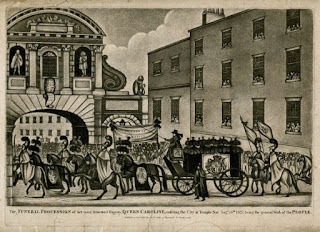Here lie interred the mortal
remains of
Richard Honey, Carpenter,
aged 36 years, and of
George Francis, Bricklayer,
aged 43 years,
who were slain on the 14th
August, 1821, while attending the
funeral of Caroline, of
Brunswick,
Queen of England
The details of that melancholy
event
Belong to the history of the
country
In which they will be recorded
Together with the public opinion
Decidedly expressed relative to
the
Disgraceful transactions
Of that disastrous day
Deeply impressed with their
fate
Unmerited and unavenged
Their respective trades
interred them
At their general expence
On the 24th of the same month
to their memory.
Richard Honey left one female
orphan.
George Francis left a widow and
three young children.
Victims like these have fallen
in every age
Stretch of pow'r or party's
cruel rage
Until even handed justice comes
at last
To amend the future and avenge
the past
Their friends and fellow-men
lament their doom
Protect their orphans, and
erect their tomb.
“Harris
I am not well, pray get me a glass of brandy,” were George IV’s first words at
being presented to his future bride, the German princess Caroline of
Brunswick. Lord Malmesbury introduced
the pair and later described what had happened. Caroline had knelt before the
then Prince of Wales who raised her to her feet and embraced her before
wordlessly retreating out of earshot and begging the footman to fetch him a
brandy. Apparently equally unimpressed Caroline turned to Malmesbury and
speaking in French told him that the prince was rather fat.
 |
| Queen Caroline in 1820 |
 |
| Queen Caroline's funeral procession |
Three
weeks later Caroline, at the age of 53, was dead. Inevitably there was speculation
that she had been killed on her husband’s orders. It had been Caroline’s wish
to be buried in Brunswick (beneath a tombstone with the epitaph ’Here lies
Caroline, the injured Queen of England’) and on 14 August her funeral cortege
set off from Brandenburgh House in Hammersmith to transport her coffin to
Harwich. The authorities, mindful of public reaction, wished to travel north of
London avoiding the city and any potential trouble but huge crowds took to the
streets and barricaded all available routes north, forcing the funeral cortege
through Westminster. In heavy rain the procession reached Hyde Park where the
soldiers of the Royal Guard tried to repeatedly force a way northwards through
an increasingly belligerent crowd. Stones and clods of mud were hurled at the
soldiers. A magistrate sanctioned them to use force and fifty shots were fired
from pistols and carbines into the crowd. Two men died, George Francis a
bricklayer at the scene and Richard Honey a carpenter a few hours later. At
their inquest the jury returned a verdict of “wilful murder against a
life guardsman unknown,” in the case of Francis and manslaughter for Honey.
No one was ever prosecuted.
 |
| George Cruikshank's caricuture of the death of Honey & Francis |

No comments:
Post a Comment